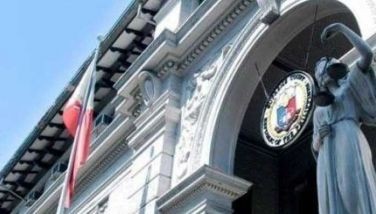Residents flee as Mayon lava flows
July 21, 2006 | 12:00am
LEGAZPI CITY — Villagers living near Mt. Mayon are starting to leave their homes, spooked by pyroclastic flow and several ash explosions on the slopes of the lava-spewing volcano.
Mushroom clouds of ash shot up into the sky starting around 7:30 a.m., sending farmers running for safety as parents took their children home from school.
It was the first time villagers started packing since the volcano started acting up Friday. The ash columns were observed along the Bonga and sMabinit gullies, facing this city and the towns of Sto. Domingo and Daraga in Albay.
Eduardo Laguerta, resident volcanologist of the Philippine Institute of Volcanology and Seismology (Phivolcs), said the pyroclastic flow did not originate from Mayon’s crater.
Laguerta said the ash clouds were caused by the collapse and disintegration of superheated lava mounds several kilometers from the crater of the 2,474-meter volcano.
He said anyone nearby could suffocate or be severely burned, as he warned people to stay away from the six-kilometer radius danger zone around Mayon.
Several thousands of residents still live and farm within the area and cannot be forced out until there is an official mandatory evacuation order.
However, amid the loud rumbling of the restive volcano, at least 20 families in three barangays of Libong, San Isidro and Fidel Surtida — all in Sto. Domingo — have left their homes as of yesterday.
Local action officer Roy Cabute said he would convince them to return to their homes since no order to evacuate has come yet.
Farmer Eladio Echaluce, 85, said he was working in his field at the farming village of Matanag on the volcano’s southeastern slope, when he heard a shout and saw someone pointing to a cloud of ash.
"When I saw the cloud, I got scared and came down," he said.
Another farmer, Loreto Aydaya, rushed along carrying a sack of vegetables and leading his two water buffalos.
"I was scared because I was about a kilometer away," he said.
Schoolteacher Jenny Perez said parents rushed to the Matanag Elementary School to fetch their children.
"I could not do anything, so I just dismissed my class," she said.
Other residents packed bags and kitchen utensils and waited on the roadside or inside their homes for village officials’ signal to evacuate.
In Lidong village in nearby Sto. Domingo town, some residents were told to leave.
Alvin Rodriguez said he was worried that his family, especially his three young children, would be overwhelmed by the ash fall.
Laguerta explained that the deadly pyroclastic flow, which boiled up to 1,000 degrees Celsius, was formed when a portion of the cascading lava pushed old deposits of volcanic debris. Together, these materials rolled towards the Mabinit gully, falling into a deep ravine believed to be filled with water.
"When these materials mixed with water, a pyroclastic flow is created. It rolled down the Mabinit gully facing Legazpi, Daraga and Sto. Domingo," he said.
Ash fall might also be experienced in Albay’s third district as a result of the pyroclastic flow event, he added.
Lava and red-hot boulders have been trickling down Mayon since Friday in a "mild and quiet" eruption, which could continue for weeks, volcanologists said.
Because of this latest development at Mayon, Phivolcs stressed no one should get near the permanent danger zone. "Events of this kind are very dangerous since pyroclastic materials are very hot and travel very fast," a volcanologist said.
In 1993, at least 78 farmers were roasted alive when pyroclastic materials were silently ejected from Mayon’s crater due to the collapse in the portion of the crater rim.
Phivolcs’ latest bulletin said that at least 404 tremors and steaming sulfur dioxide measured at 1,883 tons were recorded in the past 24 hours.
Mayon remained under level 3 of a five-step alert system, meaning that residents should prepare for eventual evacuation.
"Increased seismicity, elevated SO2 (sulfur dioxide) flux and continuous lava flow indicate that the volcano is still undergoing high level of unrest. At this stage, explosive eruptions are still possible and the probability of life-threatening pyroclastic flows resulting from this type of eruption remains high," Phivolcs warned.
Disaster officials reminded residents near the permanent danger zone to exercise appropriate readiness in case alert level 4 is raised over Mayon.
Daep however noted that volcanic debris remained confined within the danger zone radius.
"We are concerned not only for their safety, but their convenience so that we won’t recommend any evacuation if there is no need yet to do so," he said.
The 20 families who have left their homes in Sto. Domingo have sough refuge at the municipal gymnasium of the town proper, according to Cedric Daep, head of the provincial disaster management office.
Residents in Matanag were awaiting official word to evacuate.
"We only have one life to live each, it’s important to save that," said coconut farmer Romeo Nantes, 55, and a father of three.
Nantes however said that he would be tending his farm until a major eruption occurs.
Under the shade of a tree, fellow farmer Balasta Balangitan, 37, led his family and friends in planning an escape route as they watched the smoldering lava flow snake down the slopes.
Balangitan said Matanag was among the towns devastated by Mayon’s eruption in 2001, when several dozen people were killed.
In Sto. Domingo, there are five evacuation centers to accommodate evacuees from barangays Lidong, Fidel Surtida, San Isidro and Sta. Misericordia.
Meanwhile, Phivolcs director Renato Solidum arrived here yesterday to inspect the gullies and channels at the foot of Mayon in order to assess their capacity to contain volcanic debris.
Daep said it is important to know the status of these gullies to anticipate the overflowing of the big volume of lahar or mudflows in case of heavy downpour.
He said some 40,000 residents around Mayon are likely to be affected due to the incidents of mudflows overflowing from river channels.
The main gullies and channels surrounding the foot of Mt. Mayon include Bonga, Buyuan, Padang and Mabinit in Legazpi City; Miisi in Daraga, Anoling in Camalig, Basud in Sto. Domingo, Bulawanin the Malilipot-Bacacay boundary, Nasisi in Ligao City and Buang and San Vicente in Tabaco City.
Mayon is one of the country’s 22 active volcanos. Its most violent eruption in 1814 killed more than 1,200 people and buried a town in mud. A 1993 eruption killed 79 people.
The Philippines is in the Pacific "Ring of Fire," where volcanic activity and earthquakes are common. — AP, Cet Dematera, Celso Amo, AFP
Mushroom clouds of ash shot up into the sky starting around 7:30 a.m., sending farmers running for safety as parents took their children home from school.
It was the first time villagers started packing since the volcano started acting up Friday. The ash columns were observed along the Bonga and sMabinit gullies, facing this city and the towns of Sto. Domingo and Daraga in Albay.
Eduardo Laguerta, resident volcanologist of the Philippine Institute of Volcanology and Seismology (Phivolcs), said the pyroclastic flow did not originate from Mayon’s crater.
Laguerta said the ash clouds were caused by the collapse and disintegration of superheated lava mounds several kilometers from the crater of the 2,474-meter volcano.
He said anyone nearby could suffocate or be severely burned, as he warned people to stay away from the six-kilometer radius danger zone around Mayon.
Several thousands of residents still live and farm within the area and cannot be forced out until there is an official mandatory evacuation order.
However, amid the loud rumbling of the restive volcano, at least 20 families in three barangays of Libong, San Isidro and Fidel Surtida — all in Sto. Domingo — have left their homes as of yesterday.
Local action officer Roy Cabute said he would convince them to return to their homes since no order to evacuate has come yet.
Farmer Eladio Echaluce, 85, said he was working in his field at the farming village of Matanag on the volcano’s southeastern slope, when he heard a shout and saw someone pointing to a cloud of ash.
"When I saw the cloud, I got scared and came down," he said.
Another farmer, Loreto Aydaya, rushed along carrying a sack of vegetables and leading his two water buffalos.
"I was scared because I was about a kilometer away," he said.
Schoolteacher Jenny Perez said parents rushed to the Matanag Elementary School to fetch their children.
"I could not do anything, so I just dismissed my class," she said.
Other residents packed bags and kitchen utensils and waited on the roadside or inside their homes for village officials’ signal to evacuate.
In Lidong village in nearby Sto. Domingo town, some residents were told to leave.
Alvin Rodriguez said he was worried that his family, especially his three young children, would be overwhelmed by the ash fall.
Laguerta explained that the deadly pyroclastic flow, which boiled up to 1,000 degrees Celsius, was formed when a portion of the cascading lava pushed old deposits of volcanic debris. Together, these materials rolled towards the Mabinit gully, falling into a deep ravine believed to be filled with water.
"When these materials mixed with water, a pyroclastic flow is created. It rolled down the Mabinit gully facing Legazpi, Daraga and Sto. Domingo," he said.
Ash fall might also be experienced in Albay’s third district as a result of the pyroclastic flow event, he added.
Lava and red-hot boulders have been trickling down Mayon since Friday in a "mild and quiet" eruption, which could continue for weeks, volcanologists said.
Because of this latest development at Mayon, Phivolcs stressed no one should get near the permanent danger zone. "Events of this kind are very dangerous since pyroclastic materials are very hot and travel very fast," a volcanologist said.
In 1993, at least 78 farmers were roasted alive when pyroclastic materials were silently ejected from Mayon’s crater due to the collapse in the portion of the crater rim.
Phivolcs’ latest bulletin said that at least 404 tremors and steaming sulfur dioxide measured at 1,883 tons were recorded in the past 24 hours.
Mayon remained under level 3 of a five-step alert system, meaning that residents should prepare for eventual evacuation.
"Increased seismicity, elevated SO2 (sulfur dioxide) flux and continuous lava flow indicate that the volcano is still undergoing high level of unrest. At this stage, explosive eruptions are still possible and the probability of life-threatening pyroclastic flows resulting from this type of eruption remains high," Phivolcs warned.
Daep however noted that volcanic debris remained confined within the danger zone radius.
"We are concerned not only for their safety, but their convenience so that we won’t recommend any evacuation if there is no need yet to do so," he said.
The 20 families who have left their homes in Sto. Domingo have sough refuge at the municipal gymnasium of the town proper, according to Cedric Daep, head of the provincial disaster management office.
Residents in Matanag were awaiting official word to evacuate.
"We only have one life to live each, it’s important to save that," said coconut farmer Romeo Nantes, 55, and a father of three.
Nantes however said that he would be tending his farm until a major eruption occurs.
Under the shade of a tree, fellow farmer Balasta Balangitan, 37, led his family and friends in planning an escape route as they watched the smoldering lava flow snake down the slopes.
Balangitan said Matanag was among the towns devastated by Mayon’s eruption in 2001, when several dozen people were killed.
In Sto. Domingo, there are five evacuation centers to accommodate evacuees from barangays Lidong, Fidel Surtida, San Isidro and Sta. Misericordia.
Meanwhile, Phivolcs director Renato Solidum arrived here yesterday to inspect the gullies and channels at the foot of Mayon in order to assess their capacity to contain volcanic debris.
Daep said it is important to know the status of these gullies to anticipate the overflowing of the big volume of lahar or mudflows in case of heavy downpour.
He said some 40,000 residents around Mayon are likely to be affected due to the incidents of mudflows overflowing from river channels.
The main gullies and channels surrounding the foot of Mt. Mayon include Bonga, Buyuan, Padang and Mabinit in Legazpi City; Miisi in Daraga, Anoling in Camalig, Basud in Sto. Domingo, Bulawanin the Malilipot-Bacacay boundary, Nasisi in Ligao City and Buang and San Vicente in Tabaco City.
Mayon is one of the country’s 22 active volcanos. Its most violent eruption in 1814 killed more than 1,200 people and buried a town in mud. A 1993 eruption killed 79 people.
The Philippines is in the Pacific "Ring of Fire," where volcanic activity and earthquakes are common. — AP, Cet Dematera, Celso Amo, AFP
BrandSpace Articles
<
>
- Latest
- Trending
Trending
Latest
Trending
Latest
Recommended





























